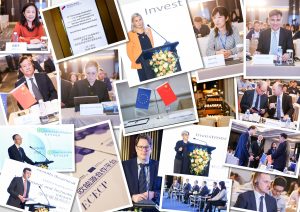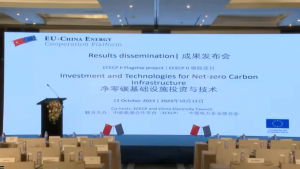![]() ECECP II Flagship Project
ECECP II Flagship Project

![]()
The China-EU Energy Cooperation Platform (ECECP) and the China Electric Power Enterprise Federation (CEC) collaborated to unveil research on net-zero carbon infrastructure investment and technology in Beijing at a side event of during the 11th China-EU Energy Dialogue. This event aimed to showcase the joint findings of Chinese and European experts, offering insights into China’s roadmap towards carbon neutrality and energy transformation. Over a hundred international energy specialists, academics, and journalists were in attendance.
Kadri Simson, the European Commission’s Energy Commissioner, remarked, “The China-EU Energy Dialogue holds significant weight in our bilateral ties. The ECECP has consistently been instrumental in driving our energy conversations forward. The unveiled research underscores the successful synergy between Europe and China in the realm of energy modeling. By sharing our methods and experiences, we’re poised to achieve meaningful strides in our future energy collaborations. I’m eager to see these methodologies integrated into China’s energy planning and cost-management strategies.”
Against enormous odds, expert energy analysts from China and the EU have worked together over the past three years to develop strategies that aim solve the vexed issue of how to integrate variable renewable energy sources into a nationwide energy system, while avoiding the risk of curtailment, stranded assets and blackouts. The EU-China Energy Cooperation Project has worked alongside China’s State Grid Energy Research Institute (SGERI), China Electricity Council (CEC) / Energy Research Institute (ERI), Ea Energy Analyses to continue their work even after being forced online during the Covid-19 pandemic, and today they release their final report.
Without cooperation between countries and regions, and sharing of expertise, there is little chance that the world will be able to escape the consequences of soaring global temperatures and extreme weather events associated with climate change.
The current report ‘Investment and Technologies for Net-Zero Carbon Infrastructure’ is the 11th report in a series of 14 EU-China projects that share expertise and knowledge so that both China and the EU can achieve their ambitious targets for climate neutrality,
It is generally accepted that Variable Renewable Energy (VRE) and Power to X (P2X) will be crucial in the race to achieve those targets. Yet new energy infrastructure, which include pipelines, power plants and carbon capture facilities, need to be planned years, if not decades, ahead and require huge investments from both private and public sources. How should those planning the transition to clean energy predict demand and consumption while factoring in variable energy generation which relies on wind and sun, which are known to be highly unpredictable? What storage options and mitigation measures should be planned for, and at what scale?
Two key challenges in planning for the net-zero scenario are identified. Firstly, the fluctuating VRE resources are hard to integrate and will bring risks to the safe operation of the power system, and secondly, a high proportion of renewable energy raises higher requirements to the market mechanisms. The power market currently lacks an effective auxiliary service market, a capacity market, a transmission rights market and other supporting mechanisms. Meanwhile, energy production is failing to keep pace with energy demand, imposing constraints on the supply side.
Since 1996, Europe has adopted measures to address market access, transparency and regulation, consumer protection, supporting interconnection and adequate levels of supply. Its most recent measures – Fit for 55 (designed to accelerate the move to climate neutrality) and REPowerEU (in response to the escalation in hostilities between Russia and Ukraine) – have demonstrated the EU’s ability to ensure security of supply even as it makes rapid adjustments to its long-term plans in response to the energy challenges facing its 27 Member States.
The EU’s energy planning systems explicitly take account of the variability of weather conditions and its impact on both VRE generation and demand. Europe’s power sector has been unbundled and liberalised, creating open markets for generation, with transmission and generation are handled separately. In terms of planning, each Member State establishes a reliability standard and performs a national assessment. At the EU level, it is the responsibility of the European Association of Transmission System Operators ENTSO-E) to prepare the adequacy assessment report, while it is the duty of the EU’s Agency for the Cooperation of Energy Regulators (ACER) to approve the report or request amendments. The assessment informs policy decisions aimed at solving capacity adequacy issues.
It is only logical, therefore, for the EU to share with China its methods and strategies for modelling so that the different challenges facing the energy industry, against a background of rising global temperatures and extreme weather events, can be taken into account.
This latest report provides an overview of modelling in the Chinese and EU energy industries, and then goes on to present models of the Chinese energy system under liberalised market conditions. These allow industry experts to work out which will yield the most accurate forecasts for how to mitigate against the risks associated with VRE.
Its initial finding is that an integrated energy system approach can enhance efficiency, promote renewable energy integration, improve flexibility and resilience, enable sector coupling and electrification, optimise costs, and support coordinated policy and planning efforts, all of which contribute to achieving decarbonisation targets more effectively.
The benefits of an integrated modelling approach are highlighted by a comparison between a series of scenarios that take account of the physical transmission infrastructure representation with a scenario that does not take account of the physical gas and X-pipelines.
Additionally, the report clarifies that alternative forms of energy commodity transportation need to be considered as part of the modelling. For example, more hydrogen pipeline capacity is likely to be constructed in provinces with high VRE potential to ship to provinces with high energy consumption.
Furthermore, when the gas pipeline infrastructure is factored in to the modelling, the usage of natural gas for power generation is higher, since the gas infrastructure has been already built and is used as long as it is economically the better option and within the emissions constraint.
With regard to P2X infrastructure additions, the results show that the utilisation rate of the X-pipelines is significantly higher in the scenarios that take account of physical transmission infrastructure. This is because once a pipeline has been built it can be used virtually cost-free.
In all the scenarios, CO2 capture and storage facilities are installed primarily in regions which have heavy industries that still emit CO2 by 2060. Also, carbon capture is mounted on power plants where biomass can be sourced, so that the CO2 can be captured and used or stored to generate negative CO2 emissions. Pipeline investments connect the captured CO2 with areas which hold carbon sequestration potential.
In general, provinces showing high volumes of carbon import and capture have high potential for carbon sequestration. It is clear that high load provinces in the centre, north and south are importing CO2, while provinces in the north-east and north-west are more export-oriented.
The examples show that an integrated system approach better represents the existing resources and ensures that they are used. This contributes to a cost-efficient transition of the energy system to achieve the net zero target.
Energy modelling is often focused on the power sector when seeking to achieve net zero targets: knowledge of how to decarbonise the power system already exists and the costs and challenges are understood. However, solutions for ‘hard-to-abate’ emissions require an integrated focus on the energy supply chain, resources, technologies, system efficiency and sector coupling.
By showcasing an integrated modelling approach of China’s electricity, gas and P2X sector, the project has strengthened the understanding of the future needs for more coordinated approaches towards energy infrastructure investment and operational planning and regulation.
This final report of the project Investments and Technologies for Net Zero Carbon Infrastructure under the EU-China Energy Cooperation Platform (ECECP) showcases not only the implementation of integrated energy system modelling, but also a successful exercise of modelling cooperation between European and Chinese teams. The project acknowledges that only through cooperation can the energy system be transformed towards a climate neutral system.
The report’s authors are clear: cooperation is key if the world is to step away from the looming climate catastrophe. Their avowed hope is that China’s energy experts are able to make use of the hard-won knowledge and experience of their EU counterparts to plan for maximum energy efficiency within the country’s energy infrastructure. ‘The time to achieve a net zero energy system is very limited. If each country develops technology on their own, it will be difficult to reach the target. The EU will not be able to reach its climate targets without China, and China will not be able to reach its climate targets in isolation from the rest of the world.’
Presentations can be downloaded via the agenda below
The dissemination workshop was held on
12 October 2023
at
THE PENINSULA BEIJING
8 GOLDFISH LANE, WANGFUJING, BEIJING 100006
and on ZOOM
Agenda
| Time | Description |
| 13:30 – 14:30 | Registration / coffee |
| 14:30 – 14:40 | Welcome speech – ECECP |
| 14:40 – 15:20 | Keynote Speeches:
|
| 15:20 – 17:00 | ECECP II Flagship Project – Investment and technologies for net-zero carbon infrastructure
|
| 17:00 – 17:30 | Q & A |
| 17:45 – 18:00 | Closing remarks |
| 18:00 – 20:00 | Networking cocktail / dinner
(Distribution of China edition of Digest of Handbook on Electricity Markets) |
